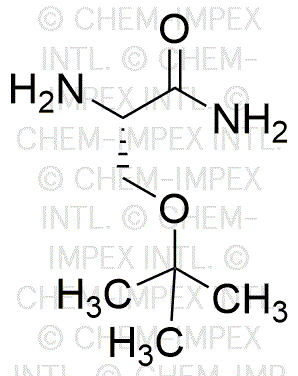H-Ser(tBu)-NH2 is widely utilized in research focused on:
- Peptide Synthesis: This compound serves as a key building block in the synthesis of peptides, particularly those requiring protected serine residues, enhancing the stability and functionality of the resulting peptides.
- Drug Development: It plays a significant role in the pharmaceutical industry for developing new drugs, especially in creating compounds that target specific biological pathways, improving therapeutic efficacy.
- Biotechnology: Used in the production of recombinant proteins, it aids in optimizing yields and enhancing the properties of proteins used in various biotechnological applications.
- Research Reagents: As a versatile reagent, it is employed in various biochemical assays, facilitating the study of enzyme activities and protein interactions.
- Cosmetic Formulations: The compound is also explored in cosmetic chemistry for its potential benefits in skin care products, contributing to formulations that promote skin hydration and protection.
General Information
Properties
Safety and Regulations
Applications
H-Ser(tBu)-NH2 is widely utilized in research focused on:
- Peptide Synthesis: This compound serves as a key building block in the synthesis of peptides, particularly those requiring protected serine residues, enhancing the stability and functionality of the resulting peptides.
- Drug Development: It plays a significant role in the pharmaceutical industry for developing new drugs, especially in creating compounds that target specific biological pathways, improving therapeutic efficacy.
- Biotechnology: Used in the production of recombinant proteins, it aids in optimizing yields and enhancing the properties of proteins used in various biotechnological applications.
- Research Reagents: As a versatile reagent, it is employed in various biochemical assays, facilitating the study of enzyme activities and protein interactions.
- Cosmetic Formulations: The compound is also explored in cosmetic chemistry for its potential benefits in skin care products, contributing to formulations that promote skin hydration and protection.
Documents
Safety Data Sheets (SDS)
The SDS provides comprehensive safety information on handling, storage, and disposal of the product.
Product Specification (PS)
The PS provides a comprehensive breakdown of the product’s properties, including chemical composition, physical state, purity, and storage requirements. It also details acceptable quality ranges and the product's intended applications.
Certificates of Analysis (COA)
Search for Certificates of Analysis (COA) by entering the products Lot Number. Lot and Batch Numbers can be found on a product’s label following the words ‘Lot’ or ‘Batch’.
Numéro de catalogue
Numéro de lot/série
Certificates Of Origin (COO)
This COO confirms the country where the product was manufactured, and also details the materials and components used in it and whether it is derived from natural, synthetic, or other specific sources. This certificate may be required for customs, trade, and regulatory compliance.
Numéro de catalogue
Numéro de lot/série
Safety Data Sheets (SDS)
The SDS provides comprehensive safety information on handling, storage, and disposal of the product.
DownloadProduct Specification (PS)
The PS provides a comprehensive breakdown of the product’s properties, including chemical composition, physical state, purity, and storage requirements. It also details acceptable quality ranges and the product's intended applications.
DownloadCertificates of Analysis (COA)
Search for Certificates of Analysis (COA) by entering the products Lot Number. Lot and Batch Numbers can be found on a product’s label following the words ‘Lot’ or ‘Batch’.
Numéro de catalogue
Numéro de lot/série
Certificates Of Origin (COO)
This COO confirms the country where the product was manufactured, and also details the materials and components used in it and whether it is derived from natural, synthetic, or other specific sources. This certificate may be required for customs, trade, and regulatory compliance.


